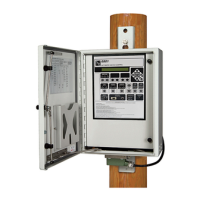Switch Control Setup
Recloser Counts to Sectionalizer Trip, Voltage Loss Only
When sectionalizing is enabled, the 3-Phase Volt Loss Sectionalizing feature is set to
the Yes or ITSG Only mode, the IntelliTeam system is in the Ready state, and the switch
control detects this number of three-phase voltage losses with no fault current, the control
opens the line switch. For example, if this value is set to 3, the switch control trips open
the line switch on the third qualifying voltage outage. (Range: 1-9; Step: 1; Default: 2)
Number of Shots Required for Lockout
Should a source-side breaker or switch inadvertently close into a fault, this is the number
of three-phase voltage losses the switch control must detect during the Shots-To-Lockout
Time Threshold condition before it trips open the switch. The switch control can lock
out after either one voltage loss or two voltage losses. Normally set this value to 1 unless
the breaker coordinating with uses an instantaneous reclose feature. (Default: One)
Shots-To-Lockout Time Threshold (seconds)
This is the number of seconds the Shots-to-Lockout timer runs. If the applicable number
of three-phase voltage losses (see the Number of Shots Required for Lockout setpoint)
occurs during this time period, the switch control trips open the switch. To enable the
Shots-to-Lockout feature, set this time to a value greater than zero. (Range: 1-25.5;
Step: 0.1; Default: 5.0)
During circuit reconfiguration, the Shots-to-Lockout timer is always used if enabled.
When the IntelliTeam system closes a switch to restore load, it will wait the Shots-to-
Lockout Time Threshold period before progressing to the next switch. This delay helps
to verify that each switch will remain closed as circuit reconfiguration continues.
Overcurrent Required before Shots-To-Lockout Operation
Enable this setpoint for the Shots-to-Lockout feature to reopen the switch only if the
three-phase voltage loss was preceded by an overcurrent event. The Shots-to-Lockout
feature was designed to look only at voltage loss to detect a breaker trip. This guards
against a misoperation caused by an incorrect fault detection or inrush restraint setting.
Enabling this setpoint is recommended when the system circuit breakers trip on inrush
current. (Default: Disabled)
If the Number of Shots Required for Lockout setpoint is two, the relationship
between the detection of overcurrent and voltage losses follows the Fault Current
Required before First/All Voltage Loss(es) setpoint.
S&C Instruction Sheet 1045-530 41

